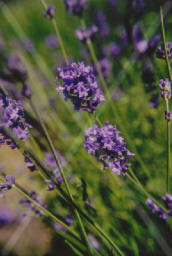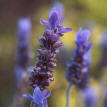

The High Country Xeriscape Council of Arizona is a non-profit 501 C-3 corporation dedicated to educating our communities about water-wise gardening. For additional information write:
HCXCA
4397 E AZ Highway 260
Payson, AZ 85541
A Favorite Plant With a Long History
By Mary Ann Walz of High Country Gardens - http://highcountrygarden.com
Lavender, lavender everywhere...and there may be a drop of it to drink, too--in lavender lemonade of course. In the past few years lavender has become quite the plant--for gardens, herbalists and crafts persons. With its current popularity, lavender graces the gardens of many homeowners and the fields of many commercial growers
Its Many Uses
Lavender's innumerable uses range from flavored vinegars and jellies to sachets, potpourri, candles, soaps, aromatic in pillows, shaving creams and cleaning supplies. Many cosmetics including bath and beauty products such as lotions, lip balms, and bath salts contain the essential oils of lavenders.
But perhaps the best use of lavender is as an ornamental plant in the garden. Its silvery leaves, fragrant flowers, and bushy growth habit make it an excellent plant for borders, rock gardens, and perennial borders. Its feathery purple spikes aren't only pretty, they also smell great. Two good books for gardeners are Lavender: The Grower's Guide by Virginia McNaughton and Lavender - How to Grow and Use the Fragrant Herb by Ellen Spector Platt.
History
Lavender is indigenous to the mountainous areas of the countries bordering the western European part of the Mediterranean region. When early travelers brought it back, the plant spread fairly rapidly to other parts of the world, and by the sixteenth century lavender was already a much-loved plant in English gardens. The first lavender plants found in America made their way here sometime after the first European settlers.
Records show lavender has been in use for over 2,500 years. The early uses of lavender were at least as numerous as today's, but they tended to be more of a medicinal nature. Biblical references to lavender are found in the gospel of Luke by the name used at that time, spikenard. Lavender was also used in ancient Egypt for mummification, and the Romans scented their public bathhouses with it. The name lavender is derived from the Latin verb lavare--to wash.
Bathing
Lavender's association with washing and bathing has an interesting history. In Medieval and Renaissance Europe, washerwomen were known as "lavenders" because they spread their laundry over lavender bushes to dry for the scent it gave. Royalty is known to have used lavender for the bath, most notably Louis XIV who loved bathing in lavender scented water.
Medicinal Applications
Lavender is known for its soothing, relaxing qualities and has been used to treat hyperactivity, insomnia, headaches, toothaches, sore joints, and rumbling digestive systems. It was also used to ward off diseases such as the plague and cholera, and in 17th century London, people tied small bunches of lavender to their wrists to prevent the deadly diseases. In the 1652 book The English Physitian, Culpeper wrote, "two spoonfuls of the distilled water of the flowers taken helpeth them that have lost their voice; as also the trembling and passions of the heart, and faintings and swounings."
Current medicinal uses promote lavender as a mild sedative and an aid to relieve neuralgia pain when used in the bath. It's also used for treating bruises and insect bites with a compress. Lavender sprays are also purported to discourage mosquitoes.
Romance Charms 
Lavender has long been considered an herb of love, and Cleopatra supposedly used it to seduce Julius Caesar and Mark Antony. In Tudor times, a lavender brew was taken by maidens on St. Luke's Day to discover the identity of their true loves. Lavender under the beds of newlyweds ensured passion, and put in the pillows of Alpine maidens it brought hopes of romance. For centuries it's long been thought to be an aphrodisiac.
Cleansings
Early household use started with lavender strewn on the floors of castles and sick rooms as a disinfectant and deodorant. It was sold in bunches by street vendors and placed in linen closets as an insecticide to protect linens from moths. Lavender was burned in sickrooms to clean the air. Many Christian homes featured lavender formed into the shape of a cross, which was then hung over the door as a safeguard against evil. In Ireland, brides wore lavender garters to protect them from witchcraft.
From its early cultivation and use to its presence in today's gardens, lavender has a long and varied history. Planting some in your garden will ensure a scent that people have enjoyed for thousands of years.
It is vitally important that watering be greatly decreased in the fall. Cacti and succulents need to dry down and begin to shrivel in preparation for winter. This is especially true when wintering plants in cold climates. Working with these particular plants is not difficult, but once you get the finer points down they can provide lots of enjoyment.
![]()
Growing Lavender
Lavender plants are easy to grow and their silver-gray foliage is ideal for moon or evening gardens. They are also used as good contrast with other showier, more colorful plants. Lavenders are also rabbit and deer resistant.
The genus Lavandula has about 28 species and is a group of ornamental herbs that thrives in hot weather, loves the sun. These plants grow well in a wide range of soils, even compost-enriched garden loams, as long as they are well drained. However, heavy, poorly-drained clay soils can be fatal. Lavender plants will be taller and wider in mild winter, hot summer climates. The same varieties when grown in cold (zone 5-6) winter climates tend to be more compact.
In spring, before the plants begin to show signs of new growth, cut back the old stems by a third to re-invigorate the plant and encourage a good show of summer flowers. Lavender plants require two to three growing seasons to reach mature size.
In the Midwest and eastern U.S., it is essential that Lavenders be planted in the sunniest spots possible in fast draining, unenriched soil (no compost). Planting on a slope or in a raised bed will facilitate faster drainage. Two inches of 3/8" diameter crushed gravel mulch around the crown is important to help with drainage.
There are two major varieties of Lavender. One is the English Lavenders (L. angustifolia), which tend to bloom in the early summer and have more compact flower spikes. For the most darkly colored flowers, 'Hidcote Superior', 'Royal Velvet' and 'Mitcham Gray' are best.
The other variety is Lavandin (L x intermedia), a hybrid between the English lavenders and Lavandula latifolia. They bloom in mid-summer and have large flowers. English lavenders flower first, beginning in late spring; the lavandins have much longer flower stems and bloom later beginning in early summer.
copyright 2003© HCXCA


